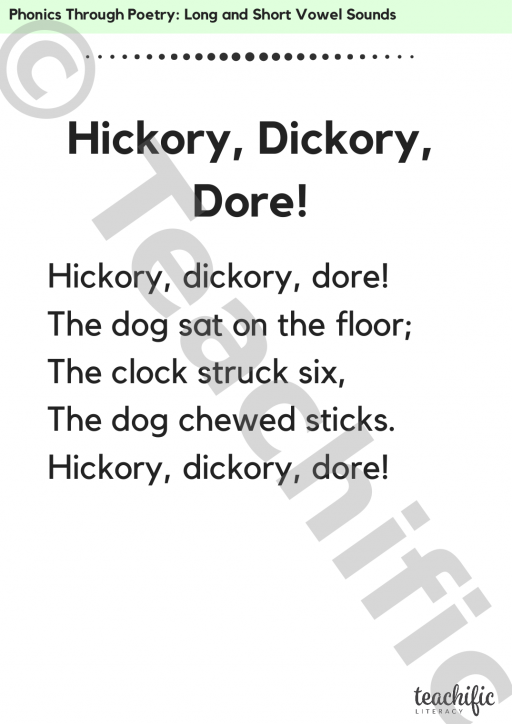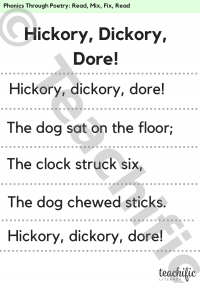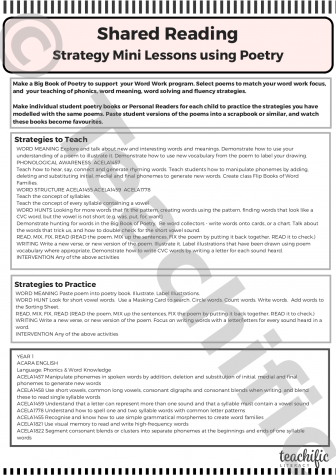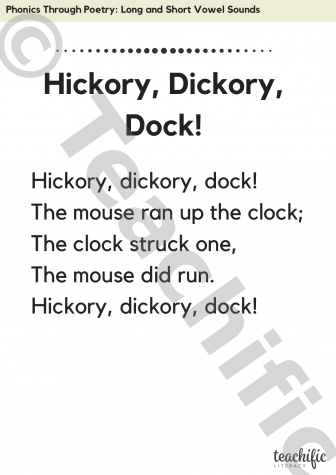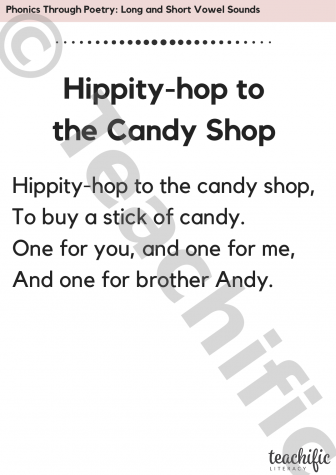About this teaching resource
The relationship between letters and sounds exists simply because letters and sounds make words. So hearing, seeing, and exploring words forms an important part of learners’ understanding of phonics – this relationship between sounds and letters.
So it’s important that we bring students a rich experience with texts, books and stories, songs and poems, so that they have rich language, a wildly huge and magnificent range of words to work with. Students need to explore, listen to, see how patterns of letters work and the different sounds they make in different words, and listen to the different sounds they hear when they say words with the same spelling pattern. It is the only place to explore the wonder, the joy, the brilliance, the complexity that is the written language of English. This is how phonics makes sense to readers and brings enormous knowledge to young writers.
Poems are invaluable for the opportunities they provide for children to hear the sounds of language and to see the spelling patterns for those sounds.
So, Phonics Through Poetry is a collection of poems that can be printed in large format – perfect for making into a Big Book of Poems.
- Read and enjoy poems daily.
- Talk about them, act them out, illustrate them (fill the big book with student created illustrations).
- Add new poems regularly (you’ll find plenty more poems here @ Teachific).
- Give students copies of poems. Add them to their Personal Reader (Text).
- Have students read the poems, act them out, illustrate them, share them with buddies.
- Return to familiar poems to start your sound/letter pattern explorations.
- Look for word families. Listen for sounds and look at the letter patterns that create those sounds.
- Look for letters and listen to the sounds they make in words.
- Explore, talk, discover.
- Chart student discoveries.
- Make the link to writing: For every sound we hear in a word we write a letter or letter pattern.
Materials: Each poem also comes with its own Read, Mix, Fix, Read strips. Poems are separated into lines, enabling readers to mix the lines, and then fix by reordering, ready to read. So it's real reading, real problem solving, real checking and monitoring, real text. Suitable for whole class, small group and individual fixing and mixing.
The top 7 things to know about Phonics: by Emmitt, Hornsby, Wilson
- Phonics is one information source in recognising words when reading, spelling words when writing, but phonics only works when students have strategies to use all sources of information available in texts.
- Whilst there are 26 letters in the English alphabet; there are approximately 43-44 sounds.
- There is not a one-to-one relationship between letters and sounds but rather between letter patterns and sounds.
- A letter by itself represents no sound; but letters represent sounds only when they occur in words.
- In written English one letter may represent more than one sound.
- The one sound may be represented by different letters.
- Children’s early writing informs teachers about children’s developing phonic understandings.’
Definition of Phonics: 'The systematic relationship between letters and sounds.' (Words Their Way: Word Study for Phonics, Vocabulary and Spelling Instruction)
Reference: If you are interested in deepening your knowledge about phonics and giving accurate information to your students I recommend this article, available freely through the Australian Literacy Educators Association:
'The Place of Phonics in Learning to Read and Write,' by Marie Emmitt, David Hornsby and Lorraine Wilson
Australian curriculum alignment
Year K
ACELA1438: Understand how to use knowledge of letters and sounds including onset and rime to spell words.
Year 1
ACELA1458: Use short vowels, common long vowels, consonant digraphs and consonant blends when writing, and blend these to read single syllable words.
Year 2
ACELA1471: Understand how to use knowledge of digraphs, long vowels, blends and silent letters to spell one and two syllable words including some compound words.
Reviews
There are no reviews for this resource yet, why not write one?
Report a problem
Please log in to report a problem with this resource
Want this teaching resource?
Members get great benefits such as FREE access to premium resources like this one, discounts on courses and more.
Download includes: PDF 2 pages 104.1 kb


